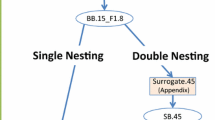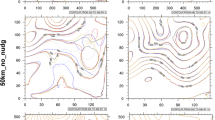Abstract
The downscaling ability of a one-way nested regional climate model (RCM) is evaluated over a region subjected to strong surface forcing: the west of North America. The sensitivity of the results to the horizontal resolution jump and updating frequency of the lateral boundary conditions are also evaluated. In order to accomplish this, a perfect-model approach nicknamed the Big-Brother Experiment (BBE) was followed. The experimental protocol consists of first establishing a virtual-reality reference climate over a fairly large area by using the Canadian RCM with grid spacing of 45 km nested within NCEP analyses. The resolution of the simulated climate is then degraded to resemble that of operational general circulation models (GCM) or observation analyses by removing small scales; the filtered fields are then used to drive the same regional model, but over a smaller sub-area. This set-up permits a comparison between two simulations of the same RCM over a common region. The Big-Brother Experiment has been carried out for four winter months over the west coast of North America. The results show that complex topography and coastline have a strong positive impact on the downscaling ability of the one-way nesting technique. These surface forcings, found to be responsible for a large part of small-scale climate features, act primarily locally and yield good climate reproducibility. Precipitation over the Rocky Mountains region is a field in which such effect is found and for which the nesting technique displays significant downscaling ability. The best downscaling ability is obtained when the ratio of spatial resolution between the nested model and the nesting fields is less than 12, and when the update frequency is more than twice a day. Decreasing the spatial resolution jump from a ratio of 12 to six has more benefits on the climate reproducibility than a reduction of spatial resolution jump from two to one. Also, it is found that an update frequency of four times a day leads to a better downscaling than twice a day when a ratio of spatial resolution of one is used. On the other hand, no improvement was found by using high-temporal resolution when the driving fields were degraded in terms of spatial resolution.















Similar content being viewed by others
References
Ahmed N, Natarajan T, Rao KR (1974) Discrete cosine transformation. IEE Trans Computers C-23: 90–93
Anthes RA, Kuo YH, Baumhefner DP, Errico RM, Bettge TW (1985) Predictability of mesoscale motions. Advance in Geophysics vol. 288, Academic Press, New York, pp 159–202
Bergeron G, Laprise R, Caya D (1994) Formulation of the Mesoscale Compressible Community (MC2) model., Cooperative Centre for Research in Mesometeorology, pp 165 (Available from Prof. R. Laprise, Département des Sciences de la Terre et de l’Atmosphére, Universitédu Québec áMontréal, C.P. 8888, Succursale “Centre-Ville,” Montréal, PQ, H3C 3P8, Canada)
Biner S, Caya D, Laprise R, Spacek L (2000) Nesting of RCMs by imposing large scales. In: Research activities in Atmospheric and Oceanic Modelling, WMO/TD - 987, Rep 30: 7.3–7.4
CAS/JSC WGNE (1999) Report of Fourteenth Session of the CAS/JSC Working Group on Numerical Experimentation (Recherche en Prévision Numérique, Environnement Canada, Doval, Québec, Canada, 2–6 November 1998). 14, WMO/TD- 964, World Meteorolgical Organisation pp 28
CAS/JSC WGNE (2000) Report of Fifteenth Session of the CAS/JSC Working Group on Numerical Experimentation (Naval Research Laboratory, Monterey, CA, USA, 25–29 October 1999). 15, WMO/TD- 1024, World Meteorological Organisation pp 29
Caya D, Laprise R (1999) A semi-implicit semi-Lagrangian regional climate model: the Canadian RCM. Mon Weather Rev 127: 341–362
Davies HC (1976) A lateral boundary formulation for multi-level prediction models. Q J R Meteorol Soc 102: 405–418
de Elía R, Laprise R, Denis B (2002) Forecasting skill limits of nested, limited-area models: a perfect-model. approach. Mon Weather Rev 130: 2006–2023
Denis B, CotéJ, Laprise R (2002a) Spectral decomposition of two-dimensional atmospheric fields on limited-area domains using the discrete cosine transform (DCT). Mon Weather Rev 130: 1812–1829
Denis B, Laprise R, Caya D, Cote J (2002b) Downscaling ability of one-way nested regional climate model: the Big-Brother Experiment. Clim Dyn 18: 627–646
Denis B, Laprise R, Caya D (2003) Sensitivity of a regional climate model to the spatial resolution and temporal updating frequency of lateral boubdary conditions. Clim Dyn 20: 107–126
Dickinson RE, Errico RM, Giorgi F, Bates GT (1989) A regional climate model for the western United States. Clim Change 15: 383–422
Giorgi F, Bates GT (1989) On the climatological skill of a regional model over complex terrain. Mon Weather Rev 117: 2325–2347
Giorgi F, Mearns LO (1999) Introduction to special section: regional climate modeling revisited. J Geophys Res 104: 6335–6352
Hong S-Y, Leetmaa A (1999) An evaluation of the NCEP RSM for regional climate modeling. J Clim 12: 592–609
Jones RG, Murphy JM, Noguer M (1995) Simulation of climate change over Europe using a nested regional-climate model. I: assessment of control climate, including sensitivity to location of lateral boundaries. Q J R Meteorol Soc 121: 1413–1449
Jones RG, Murphy JM, Noguer M, Keen AB (1997) Simulation of climate change over Europe using a nested regional-climate model. II: comparison of driving and regional model responses to a doubling of carbon dioxide. Q J R Meteorol Soc 123: 265–292
Kain JS, Fritsch JM (1990) A one-dimensional entraining/detraining plume model and its application in convective parameterization. J Atmos Sci 47: 2784–2802
Laprise R, Caya D, Bergeron G, Giguére M (1997) The formulation of AndréRobert MC2 (Mesoscale Compressible Community) model. In: Lin C, Laprise R, Ritchie H (eds) The André J. Robert Memorial Volume, companion volume to Atmos-Ocean 35: 195–220
Laprise R, Caya D, Giguére M, Bergeron G, CotéH, Blanchet J-P, Boer G, McFarlane AN (1998) Climate and climate change in western Canada as simulated by the Canadian regional climate model. Atmos-Ocean 36: 119–167
Laprise R, Ravi Varma MK, Denis B, Caya D, Zawadzki I (2000) Predictability in a nested limited-area model. Mon Weather Rev 128: 4149–4154
Leung LR, Ghan SJ (1999) Pacific Northwest climate sensitivity simulated by a regional climate model driven by a GCM. Part I: control simulations. J Clim 12: 2010–2030
Marinucci MR, Giorgi F (1992) A 2XCO2 climate change scenario over Europe generated using a limited area model nested in a general circulation model. I: present-day climate simulation. J Geophys Res 97: 9989–10009
Peagle J, Yang Q, Wang M (1997) Predictability in limited area and global models. Meteorol Atmos Phys 63: 53–69
Robert A, Yakimiw E (1986) Identification and elimination of an inflow boundary computational solution in limited area model integrations. Atmos-Ocean 24: 369–385
Takle ES, Gutowski WJ, Jr., Arritt RW, Pan Z, Anderson CJ, da Silva RR, Caya D, Chen S-C, Giorgi F, Christensen JH, Hong S-Y, Juang H-MH, Katzfey J, Lapenta WM, Laprise R, Liston GE, Lopez P, McGregor J, Pielke RA Sr, Roads JO (1999) Project to Intercompare Regional Climate Simulations (PIRCS): description and initial results. J Geophys Res 104: 19,443–19,461
Taylor KE (2001) Summarizing multiple aspects of model performance in a single diagram. J Geophys Res 106: 7183–7192
Vukucevic T, Errico R (1990) The influence of artificial and physical factors upon predictability estimates using a complex limited-area model. Mon Weather Rev 118: 1460–1482
Warner TT, Peterson RA, Treadon RE (1997) A tutorial on lateral boundary conditions as a basic and potentially serious limitation to regional numerical weather prediction. Bull Am Meteorol Soc 78: 2599–2617
Yakimiw E, Robert A (1990) Validation experiments for a nested grid-point regional forecast model. Atmos-Ocean 28: 466–472
Acknowledgements
This work was funded by the Canadian Foundation for Climate and Atmospheric Sciences (CFCAS) and the Consortium “Ouranos” for regional climate and climate-change impact studies. We are also greatful to the regional climate modelling staff at UQAM for their valuable technical help with the Canadian RCM, and to Claude Desrocher for maintaining a user-friendly computing environment.
Author information
Authors and Affiliations
Corresponding author
Additional information
An erratum to this article is available at http://dx.doi.org/10.1007/s00382-005-0046-z.
Rights and permissions
About this article
Cite this article
Antic, S., Laprise, R., Denis, B. et al. Testing the downscaling ability of a one-way nested regional climate model in regions of complex topography. Climate Dynamics 23, 473–493 (2004). https://doi.org/10.1007/s00382-004-0438-5
Received:
Accepted:
Published:
Issue Date:
DOI: https://doi.org/10.1007/s00382-004-0438-5




